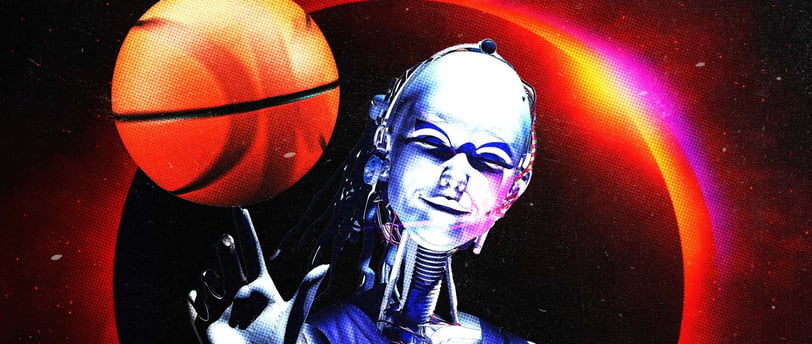DraftGPT: AI Invests in NBA Scouting
Deciphering the use of artificial intelligence to boost prospect evaluation.
BASKETBALL
By Emmanuel Louis
6/26/20257 min read


Introduction to DraftGPT
DraftGPT is a cutting-edge artificial intelligence platform designed to revolutionize the way NBA teams approach scouting and evaluating draft prospects. Launched in 2023, this innovative technology has emerged amidst the growing trend of utilizing data-driven methodologies in sports. As teams strive to gain a competitive edge, the integration of AI into the scouting process represents a significant shift towards a more analytical and evidence-based approach.
The development of DraftGPT was influenced by the recognition that traditional scouting methods rely heavily on subjective assessments. While human intuition and experience are invaluable, they can sometimes fall short in quantitatively assessing a player’s potential. Consequently, NBA franchises have begun to adopt sophisticated AI tools that analyze player performance metrics, physiological data, and game footage to derive insights. DraftGPT taps into this capacity, merging machine learning capabilities with an extensive database of historical player information to support decision-making during the draft process.
Moreover, the role of artificial intelligence in NBA scouting has become increasingly pertinent, as the league continues to evolve in terms of athleticism, skill sets, and competition levels. By employing DraftGPT, teams can enhance their scouting strategies, enabling them to identify and evaluate talent more efficiently. This technology accentuates the importance of embracing a data-driven approach, allowing scouts and analysts to decipher patterns and trends that may have otherwise gone unnoticed.
As NBA teams continue to explore the potential of artificial intelligence, DraftGPT stands at the forefront of this transformation in player scouting. By utilizing advanced algorithms and systematic analysis, DraftGPT marks a new era in the evaluation of draft prospects, ensuring that teams make informed decisions that can shape their future success.
How DraftGPT Works
DraftGPT leverages advanced machine learning algorithms to analyze a multitude of data sources, facilitating its ability to evaluate NBA prospects comprehensively. The system processes various forms of data, including player profiles, performance statistics, and audio clips, ensuring a holistic understanding of a player's potential. This multifaceted approach enhances the accuracy of DraftGPT's assessments and predictions.
At the core of DraftGPT's functionality is its ability to parse and interpret large datasets. By employing natural language processing techniques, the AI can evaluate written commentary, scouting reports, and player interviews, converting qualitative insights into quantitative metrics. Performance statistics, such as shooting percentages, assists, and rebounds are meticulously analyzed, allowing the AI to identify patterns and trends that influence a player's trajectory in the league.
Moreover, DraftGPT's machine learning algorithms utilize supervised learning, where the system is trained on historical data involving past prospects and their career outcomes. By comparing the attributes of current players against this extensive dataset, DraftGPT can create predictive models that estimate future performance. It continually refines these models through unsupervised learning, recognizing intricate relationships within the data that were not explicitly defined at the outset.
In addition to player statistics, DraftGPT incorporates video analysis through computer vision algorithms, which examine players’ movement, shooting form, and defensive capabilities. This allows the system to gauge intangibles such as athleticism and game awareness. The integration of diverse data forms culminates in comprehensive evaluations, equipping teams with the insights needed for informed scouting decisions. Overall, DraftGPT symbolizes a significant advancement in the intersection of artificial intelligence and sports analytics, enhancing the scouting process in the NBA.
The Advantages of AI in Scouting
The integration of AI technology, such as DraftGPT, into the NBA scouting process has introduced a transformative approach to player evaluation. One of the primary advantages of utilizing AI in scouting is its ability to analyze vast amounts of data at a speed and accuracy that far surpasses traditional methods. By processing statistics, game footage, and performance metrics, AI can provide deeper insights into a player's capabilities, highlighting strengths and weaknesses that may not be immediately apparent to human scouts. This data-driven analysis allows teams to make more informed decisions in their draft strategies.
Moreover, AI systems can be programmed to identify patterns and trends in player performance over time. By studying historical data and player behavior, AI tools can predict future performance, enabling organizations to identify potential prospects who might fit their playing style and team dynamics. This predictive modeling is particularly beneficial for teams looking to establish a competitive edge in the highly competitive landscape of the NBA.
Another significant benefit of employing AI in scouting is the reduction of human error. Human scouts, while knowledgeable and experienced, are still susceptible to biases and oversight. By utilizing AI algorithms, teams can minimize these inconsistencies, as AI provides objective analyses based solely on data rather than subjective interpretations. This factor can lead to more equitable assessments of talent, ensuring that decision-makers consider all prospects fairly irrespective of personal biases.
In addition to enhancing accuracy, AI can significantly increase efficiency in the scouting process. By automating tasks such as data collection and preliminary analysis, scouts can allocate more time to on-the-ground assessments and relationship-building with players. This blend of technology and traditional methodologies creates a more holistic scouting strategy, one that is both comprehensive and effective.
Limitations and Challenges
While DraftGPT presents a substantial advancement in the realm of NBA scouting, it is imperative to acknowledge the limitations and challenges intrinsic to its implementation. One notable concern revolves around potential biases present in the data utilized by the AI model. If the training data encompasses historical biases—such as over-representation of certain player profiles or demographics—the AI may inadvertently replicate these biases in its recommendations. This could lead to skewed player evaluations and hinder the inclusion of deserving talents who do not conform to established patterns.
Furthermore, the effectiveness of DraftGPT is largely contingent on the quality and quantity of input data. In scenarios where scouting data is incomplete, outdated, or incorrectly labeled, the output produced by the AI may suffer significantly. The discrepancies or gaps in data could result in flawed assessments, thereby complicating decision-making for scouts and team managers. Consequently, it emphasizes the crucial need for meticulous data curation and validation to ensure that DraftGPT operates on a foundation of accurate information.
Another challenge associated with using DraftGPT lies in the transparency of its decision-making processes. AI systems often function as "black boxes," where the rationale behind specific recommendations is not readily apparent. This opaqueness creates a barrier for scouting professionals who require rational, explainable justification for their player choices. Understanding the criteria and analytical methods applied by the AI is essential for instilling trust among scouts and franchises. Without this transparency, organizations may struggle to adopt AI-driven solutions confidently in their scouting methodologies. Addressing these limitations is essential for maximizing the impact of DraftGPT on the future of NBA scouting.
Case Studies: Successful Implementation
The integration of DraftGPT into NBA scouting processes has led to notable successes for various teams, showcasing how artificial intelligence can enhance player evaluation and selection. One prominent example is the use of DraftGPT by a mid-market franchise that had struggled to compete in the league. By leveraging the AI's capability to analyze vast amounts of data on college players, the team was able to identify several undervalued prospects who were overlooked by traditional scouting methods. As a result, they successfully drafted players who later became essential contributors to the team's performance.
Another team, known for its innovative approach, utilized DraftGPT to predict player development trajectories with remarkable accuracy. By inputting historical performance data and various metrics into the AI model, they were able to forecast how college athletes would adapt to the professional game. This predictive capability allowed the franchise to make informed decisions on which prospects to develop further, significantly reducing the risk associated with high-stakes draft picks. Through this strategic application of DraftGPT, the organization not only improved its draft outcomes but also fostered a more effective player development program.
Moreover, some teams have integrated DraftGPT into their decision-making processes on draft day, allowing coaches and executives to factor in AI-generated insights alongside traditional scouting reports. By combining qualitative assessments from human scouts with quantitative data analyzed by DraftGPT, teams have crafted a more rounded perspective of each candidate. This synergy has frequently resulted in identifying the best possible fit for their roster needs, thus maximizing their potential success both on and off the court. Such successful implementations of DraftGPT illustrate the transformative impact of AI in the NBA scouting landscape.
The Future of AI in Basketball Scouting
As technology continues to advance, the role of artificial intelligence (AI) in basketball scouting is poised for significant evolution. The integration of AI into player evaluation and recruitment has already begun to reshape traditional scouting methods, and future developments promise to enhance this transformation even further. One potential advancement lies in the refinement of predictive analytics. Enhanced algorithms may soon allow teams to assess not only a player's current performance but also their potential growth trajectory based on various factors, including age, skill development, and even psychological resilience.
Another key area of development is the increasing sophistication of video analysis. AI systems are likely to become more adept at analyzing game footage, breaking down player movements, and providing insights into decision-making processes on the court. This technology could assist scouts in identifying emerging talents who exhibit qualities that may not be immediately evident through conventional methods. By integrating data from wearables, AI can monitor players' physical conditions in real-time, alerting teams to potential injuries before they become serious issues.
The relationship between human scouts and AI is also expected to evolve. While AI can process vast amounts of data and generate valuable insights, the expertise and intuition of seasoned scouts remain indispensable. Rather than replacing human scouts, AI will likely serve as a complementary tool, allowing scouts to focus more on qualitative assessments and personal interactions with players. This collaboration may lead to a more nuanced evaluation process that combines the strength of data-driven analysis with the human touch.
As teams continue to embrace AI-enhanced strategies, the future of basketball scouting may become a fine balance between technology and traditional insight, ultimately creating a more informed approach to player recruitment that aligns with team objectives and performance goals.
Conclusion
In recent years, the integration of artificial intelligence in various industries has marked a significant evolution, and the realm of sports is no exception. The introduction of DraftGPT showcases a pivotal advancement in NBA scouting, where cutting-edge technology offers streamlined data analysis and analytics-driven insights. By harnessing vast datasets, DraftGPT has the potential to identify player talents that might be overlooked through conventional scouting methods.
However, while the use of AI tools like DraftGPT enhances the efficiency and accuracy of talent evaluation, it is essential to acknowledge the irreplaceable value of traditional scouting practices. Scouting has historically relied on human intuition and experience, factors that allow for a nuanced appraisal of a player's abilities beyond mere statistics. The key, therefore, lies in striking a harmonious balance between these two methodologies—utilizing DraftGPT's data-driven insights while still respecting the insights gained from experienced scouts who can interpret those metrics in the context of game dynamics and personal presentations.
Furthermore, the conversations surrounding the evolving landscape of sports analytics suggest a future where AI and human expertise converge. This collaboration can lead to more informed decision-making processes, empowering teams to uncover emerging talent more effectively. As the field of player evaluation continues to develop, the impact of DraftGPT in revolutionizing NBA scouting should not be understated. It opens new avenues for assessing player potential and growth, driving advancements that can shape the game's future.
As readers consider these developments, it is clear that the intersection of AI technology and traditional scouting methods presents exciting prospects for the NBA. The journey towards optimal talent identification is ongoing, and the adoption of tools like DraftGPT underscores a commitment to innovation in sports and player evaluation.
